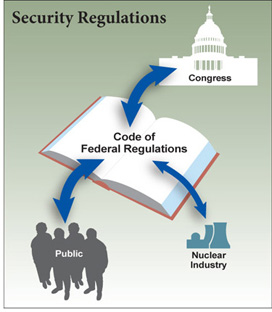|
|
Home > Electronic Reading Room > Document Collections > Fact Sheets > Rulemaking Overview

|
 Rulemaking Overview Rulemaking Overview
Immediately after the 9/11 terrorist attacks, the NRC advised nuclear facilities to go to the highest level of security. After that, the NRC issued a series of mandates – called Orders – to further strengthen security. The NRC is taking a multifaceted approach to security enhancements in the post-9/11 threat environment. The NRC has raised the security of existing nuclear power plants while also requiring new security features in the design of new reactors that may be built in coming years.
Most recently, three new rulemakings provide additional security enhancements.
- One rule, issued by the NRC in March 2007 after extensive public comment, modifies and enhances the Design Basis Threat.
- A second rule, which was issued for public comment in 2006, proposes enhancements to the physical security at nuclear power plants. Among other things, the proposed rule addresses access controls, event reporting, security personnel training, safety and security activity coordination, contingency planning, cyber and radiological sabotage protection.
- A third rule, still in the early stages, will propose additional aircraft impact assess ments for new power reactor designs.
|

|
|
How Rulemaking Works
- Rules – or regulations – and their enforcement are how the NRC protects people and the environment. Nuclear power plants must adhere to the rules or risk serious repercussions – up to closing a plant down. A new rule may be proposed by the NRC’s five-member Commission, because of a petition from the public or as suggested by the NRC staff based on research or actual events. Once developed, a proposed rule is published in the Federal Register for a public comment period, usually 75 to 90 days. Once the comment period has closed, the NRC staff analyzes the comments, makes any needed changes, and forwards the final rule to the NRC Commissioners for approval. If approved, the final rule is published in the Federal Register and usually becomes effective in 30 days.
|
|
|
